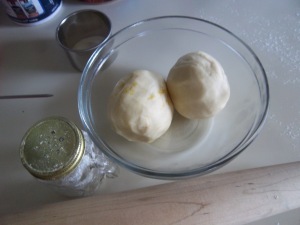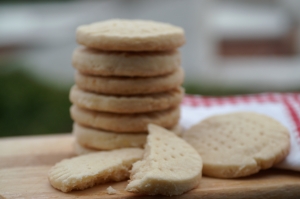The history of shortbread goes back to at least the 12th century and originally started life as ‘biscuit bread’; biscuits that were made from left-over bread dough that was sometimes sweetened and dried out in the oven to form a hard, dry rusk. This practise took place over the whole of the British Isles, not just Scotland.
Over time the leavening was lost and exchanged for butter, making it an expensive fancy treat that was only bought for celebrations such as Christmas and Hogsmanay (Scottish New Year). There are similar ‘breads’ outside of Scotland such as Shrewsbury cakes and Goosnagh cakes.
The large amount of butter is what makes shortbread short: the term short, when applied to biscuits and pastry, means crumbly, like shortcrust pastry should be. It is the reason why the fat added to biscuits and pastries is called shortening.
Mary Queen of Scots
Today, shortbread is made from flour, butter and sugar, though other flavourings are added. Caraway was particularly popular; Mary Queen of Scots was particularly fond of them. Other extra ingredients included almonds and citrus fruits like this 18th century recipe from Mrs Frazer:
Take a peck of flour…beat and sift a pound of sugar; take orange-peel, citron, and blanched almonds, of each half a pound, cut in pretty long thin pieces: mix these well in the flour; then make a hole in the middle of the flour, put in three table-spoons of good yeast; then work it up, but not too much…roll out; prickle them on top, pinch them neat round the edges, and strew sugar, carraways, peel, and citron, on the top. Fire it…in a moderate oven.
In George Read’s 1854 book The complete biscuit and gingerbread baker’s assistant, there are fewer ingredients, but includes eggs for some reason:
1 ¼ lb. of flour, ½ lb. of sugar, ½ lb. of butter, 3 eggs, ¼ oz. of volatile salts…a little essence of lemon
FYI: Volatile salts were smelling salts, that could also be used to leaven dough.
Shortbread usually comes in three different forms: small round biscuits, fingers or large rounds. To make the fingers, dough is cut into a large rectangle and the fingers are scored with the back of a knife so they can be broken up easily after cooking. A pattern made with fork marks is always made too.
To make large rounds, the dough is pressed into a round earthenware mould or a tart tin to make petticoat tails. When making the petticoat tails, the dough is scored into triangular slices like a pizza. The term petticoat tails comes not from the French petites gatelles (‘little cakes’) as many think (though Scottish cuisine did have more in common with French food than English food during the reign of Mary Queen of Scots), but from the term petticoat tallies – the name of the triangular pattern used to make bell hoop petticoats like Elizabeth I would have worn.
You can still buy the earthenware moulds – I’ll be buying one when I move back to England later in the summer.
Basic shortbread
This recipe makes enough for two petticoat tails rounds made in a seven inch tart tin. It’s hard to say how many biscuits or fingers – it depends on how wide and thick you make them. The important thing is to take them out before they start to brown.
To achieve a nice melt-in-the-mouth crumbliness use cornflour as well as normal plain flour to make your shortbread. Somewhere between a 1:1 and a 3:1 ratio of plain flour to cornflour works well. You don’t have to do this; they are still good with just good old plain flour.
6 ounces flour mix
4 ounces salted butter cut into cubes
2 ounces icing or caster sugar, plus extra
extra caster sugar
Rub the butter into the flour using fingers, pastry blender, food mixer or processor; be careful not to overwork things though if you’re using a food processor – shortbread dough doesn’t like being handled too much. Stir in the sugar and with your hand bring everything together to make a pliable dough – it’ll feel like it won’t form a dough at first, but as your hands warm it will.
Now you can roll or press out your dough into whatever shape you like and then place in the fridge for 20-30 minutes to harden:
For petticoat tails you are best diving the two into two halves and pressing the dough into your fluted flat tin. Score lines to mark out the slices, using a ruler if you want to be really precise. Make a nice pattern with a fork.
For fingers roll out the dough to half an inch thickness into a vaguely rectangular shape. Use a knife and a ruler to cut out a large rectangle and then score the lines with your ruler and knife, making patterns with your fork prongs.
For biscuits you can really do whatever you like; thick, thin, round, square. I think a little under half an inch is a good thickness. Cut out the biscuits and make your all-so-important fork marks.

Heat the oven to 180⁰C (350⁰F). Place the biscuits onto a baking sheet lined with greaseproof paper. Sprinkle with the extra sugar and bake until cooked but before any signs of browning. Petticoat Tails and fingers take about 15 minutes, individual biscuits can be variable, but usually about 12-15 minutes.
Variations:
For lemon shortbread add the zest of one lemon when you add the sugar, and for almond shortbread add 5 or 6 drops of almond extract. If you want to try it with caraway, sprinkle in 2 teaspoons of caraway seeds at the same time you add the sugar.
If you like the blogs and podcast I produce, please consider treating me to a virtual coffee or pint, or even a £3 monthly subscription: follow this post for more information.





what an interesting history. And the shortbreads look delicious.
LikeLike
Thank you! I aim to please!
LikeLike
According to my grandmother they were only petticoat tails if a ring was cut out of the middle – so they really were just like a miniature petticoat pattern. She said they cooked more evenly that way – haven’t tried doing both at the same time so I don’t know if she was right.
And of course they are “biscuits” like “biscotti” becaouse they are bis cuits – cooked twice. Sliced after the initial cooking and then dried out slowly. In fact Mrs Frazer’s recipe looks like a pretty classic biscotti recipe
On Sal Volatile aka Hartshorn aka bakers ammonia in baking, the swedes still use it and you can get it in any Swedish supermarket. In the US you can get it from King Arthurs. It is brilliant in thin crispy cookies – they stay crispy after cooking much better than baking powder raised ones do. Don’t know where to get it in the UK – friend brings me it from Sweden
LikeLike
They are indeed biscuits, though it didn’t stop them from being overlooked for taxations: bread didn’t get taxed, but biscuits did. Not unlike the recent Jaffa ‘Cake’ scandal.
And yes – the twice baked thing is true – I was saving it for a later, more general, bikkie themed post!
Never seen the centre cut out, but that would make them a true hoop petticoat…
LikeLike
my grand mother who came fromscottland at the age of
15 taught all 5 of her daughters and there daughters how to
make shorting bread so well when you bite it .it melts in your
mouth like a fine piece of chocolate the recipe is differant than i have ever
read so I think i shall keep it a nice familey seacret!
merry x mas
brenda j loya
LikeLike
It’s funny you should mention alternative recipes – I have just found a load of them in an old Scottish cook book that are very different from mine. I’ll try and do a post on them.
You are right to keep yours secret, but if you ever change your mind, let me know!
Thanks for the post,
Neil
LikeLike
Pingback: Short Bread | Transplanted Cook
Pingback: The 12 Days of Exquisiteness: Day 11: A Shortbread Recipe | Exquisite Vintage Teas
Pingback: Homemade Cookies for when you can’t get Girl Scout Trefoils and Samoas | Bake, Gobble & Run
Pingback: Sources | scottishfoods
Reblogged this on The Life of a Gypsy Heart…. and commented:
Here is today’s ‘Cookie of The Day’ truly traditional Scottish Shortbread.
LikeLike
Pingback: Episode Seven: Shortbread and Lemon Bars | stovetop alchemist
This is fascinating and I would love to quote you in my shortbread recipe post if that’s ok? The history of shortbread is wonderful to read 🙂 Thank you for sharing and love your recipes too!
LikeLiked by 1 person
I’m very glad you like my posts and recipes! Of course you can quote me – any questions, let me know
Neil
LikeLiked by 1 person
Thank you! I have put a link to your post on my latest post. Really appreciate it and thanks for your permission 👍
LikeLike
Pingback: Chocolate Dipped Shortbread Cookies - Great Eight Friends
Pingback: Strawberry Rhubarb Shortcakes - Dig In With Dana
Pingback: Tour of a shortbread factory | Crafty Tours of Scotland
Pingback: El origen de estas galletas lo encontramos en un postre medieval.
Pingback: Galletas escocesas | ¿Te atreves a hacerlas tu mism@?
Pingback: That’s the short of it – Scotch & Scones
Pingback: The Long and Short of It – Milk + Honey
Pingback: The Best Simple Two Way Shortbread Cookies
Pingback: Baking the taste of Christmas past is a reminder of our good fortune | Vancouver Sun
Pingback: That's the short of it: Homemade Shortbread - Scotch & Scones
The history is very interesting. I lived in Scotland for 15 years and for some reason I now forget added a small amount of home-made rice flour to give the shortbread a little crunchiness. I can’t imagine I made that up so wondered whether you’d come across that variation. Cheers.
LikeLike
Yes you can use rice flour instead of cornflour…they do the same job as they’re are gluten free flours
LikeLike
I have a recipe that calls for rice flour and it works well
LikeLiked by 1 person
Pingback: That's the short of it: Homemade Shortbread - Scotch & Scones
Pingback: Phenomenal Scottish Shortbread | Soy Basil
Pingback: 10 Traditional British Food Items You Can Try Baking at Home - Nigerian Dating Site
Pingback: Versatile, Scrumptious Chocolate Shortbread Cookies | Edible Times
Pingback: Lemon Slice Shortbread Cookies - Bertuzzo
Pingback: The History of Shortbread – A Scottish Pastry with a Rich History - ManyEats
Pingback: strawberries and cream thumbprint cookies - Bertuzzo
Pingback: Shortbread for Christmas - with your coffee
Pingback: Shortbread – The Biscuit Bestiary
Pingback: What Are Shortbread Biscuits? | Hotel ChocolatThe Pod | The Hotel Chocolat Blog
Pingback: Hotel Chocolat : What are shortbread biscuits? – Marijuana Xr Research
Pingback: Best shortbread recipe - an Italian in my kitchen - Tamsynlewis
Pingback: Shortbread Caramel Almond Bars
Pingback: What cookie embodies your zodiac sign, according to an astrologer - Kello News
Pingback: Nutella Chip Shortbread Cookies – An Italian in my Kitchen
Pingback: Sencillas galletas de mantequilla – de dos maneras - Biohazard-stage
I love all the snippets of history Neil. I’ll give Jane’s recipe a try next time I bake shortbread. Dor x
LikeLike
Thanks Dor! Let me know how you get on x
LikeLike
Pingback: Las mejores galletas de mantequilla - Biohazard-stage
Pingback: Stamped Shortbread Cookies Recipe – An Italian in my Kitchen – Cooking recipes dinner
Pingback: The Quintessential Guide to Shortbread Recipes: The Top 5 You Cannot Miss! | Stay Positive Blog